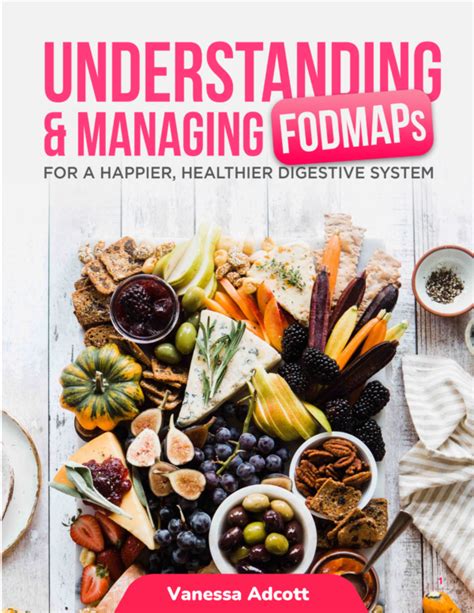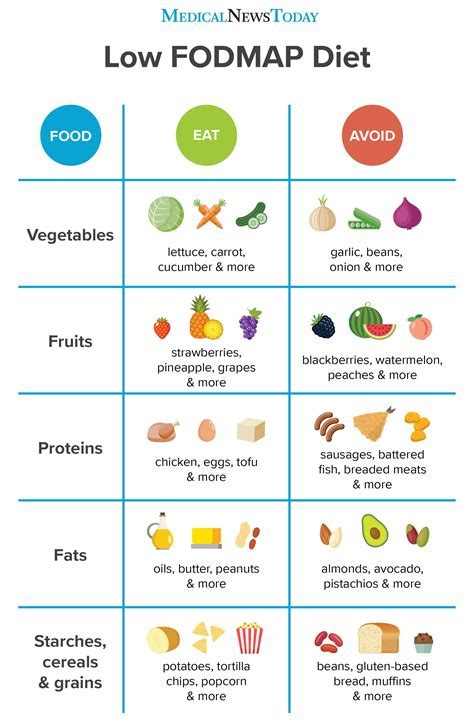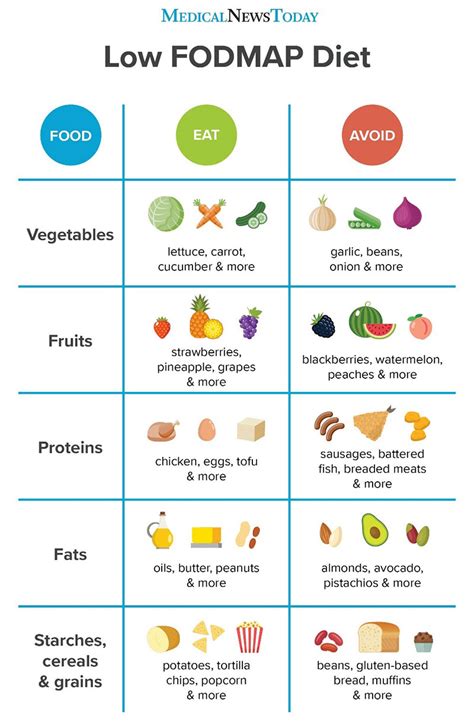Intro
Manage IBS symptoms with a Low FODMAP diet, reducing irritable bowel syndrome discomfort through tailored food choices, gut-friendly recipes, and digestive relief strategies.
Managing Irritable Bowel Syndrome (IBS) can be a challenging and frustrating experience for those affected. IBS is a common disorder that affects the large intestine, causing symptoms such as abdominal pain, bloating, gas, diarrhea, and constipation. While the exact cause of IBS is still unknown, research has shown that dietary changes can play a significant role in alleviating symptoms. One such dietary approach that has gained popularity in recent years is the Low FODMAP diet. In this article, we will delve into the world of FODMAPs, explore the benefits of a Low FODMAP diet for IBS relief, and provide a comprehensive guide on how to implement this diet into your daily life.
The term FODMAP is an acronym that stands for Fermentable Oligo-, Di-, Mono-saccharides, and Polyols. FODMAPs are types of carbohydrates that are found in a wide range of foods, including fruits, vegetables, grains, and dairy products. For some individuals, FODMAPs can be difficult to digest, leading to an increase in symptoms such as bloating, gas, and abdominal pain. The Low FODMAP diet involves limiting or avoiding foods that are high in FODMAPs, with the goal of reducing IBS symptoms and improving overall digestive health.
Understanding FODMAPs

How FODMAPs Affect the Body
When FODMAPs are consumed, they are not fully digested in the small intestine. Instead, they are fermented by bacteria in the large intestine, producing gas and leading to an increase in symptoms such as bloating, gas, and abdominal pain. For individuals with IBS, the gut is more sensitive to FODMAPs, making it even more challenging to digest these carbohydrates. By limiting or avoiding FODMAPs, individuals with IBS can reduce the amount of undigested carbohydrates in the gut, thereby alleviating symptoms and improving digestive health.Benefits of a Low FODMAP Diet

- Reduced bloating and gas
- Improved bowel habits
- Decreased abdominal pain
- Enhanced overall digestive health
Implementing a Low FODMAP Diet
Implementing a Low FODMAP diet can seem overwhelming, but with a clear understanding of which foods to limit or avoid, individuals with IBS can take the first step towards alleviating symptoms. The following are some general guidelines to follow: * Limit or avoid foods high in fructose, such as apples, pears, and watermelon * Limit or avoid lactose-containing foods, such as milk, ice cream, and soft cheeses * Limit or avoid foods high in fructans, such as wheat, barley, and rye * Limit or avoid legumes, such as beans and lentils * Limit or avoid foods containing polyols, such as sugar-free gum and candyFoods to Eat on a Low FODMAP Diet

Meal Planning and Grocery Shopping
Meal planning and grocery shopping can be challenging on a Low FODMAP diet, but with some planning and creativity, individuals with IBS can enjoy a variety of delicious and nutritious meals. Some tips for meal planning and grocery shopping include: * Plan meals in advance to ensure that Low FODMAP ingredients are on hand * Shop the perimeter of the grocery store, where fresh fruits and vegetables are typically located * Read food labels carefully to ensure that products are Low FODMAP * Consider working with a registered dietitian or healthcare provider to develop a personalized meal planCommon Challenges and Solutions

Some solutions to these challenges include:
- Researching Low FODMAP restaurants and menus in advance
- Carrying a list of Low FODMAP foods with you when grocery shopping
- Finding creative ways to prepare and enjoy Low FODMAP meals
Working with a Healthcare Provider
Working with a healthcare provider, such as a registered dietitian or gastroenterologist, can be incredibly helpful in implementing and maintaining a Low FODMAP diet. A healthcare provider can: * Help individuals identify trigger foods and develop a personalized meal plan * Provide guidance on how to read food labels and identify Low FODMAP ingredients * Offer support and encouragement throughout the processConclusion and Next Steps

We invite you to share your experiences and questions about the Low FODMAP diet in the comments section below. Have you tried a Low FODMAP diet? What challenges have you faced, and how have you overcome them? Share your story and help others who may be struggling with IBS symptoms.
What is the Low FODMAP diet?
+The Low FODMAP diet is a dietary approach that involves limiting or avoiding foods that are high in FODMAPs, which are types of carbohydrates that can be difficult to digest.
What are the benefits of a Low FODMAP diet?
+The benefits of a Low FODMAP diet include reduced bloating and gas, improved bowel habits, decreased abdominal pain, and enhanced overall digestive health.
How do I implement a Low FODMAP diet?
+To implement a Low FODMAP diet, it is recommended to work with a healthcare provider, such as a registered dietitian or gastroenterologist, to develop a personalized meal plan and identify trigger foods.
What foods are allowed on a Low FODMAP diet?
+Foods that are allowed on a Low FODMAP diet include fresh fruits, such as bananas and berries, vegetables, such as lettuce and cucumbers, proteins, such as chicken and fish, and grains, such as rice and quinoa.
How long does it take to see results on a Low FODMAP diet?
+Results on a Low FODMAP diet can vary, but many individuals experience significant improvements in symptoms within 2-6 weeks of starting the diet.
